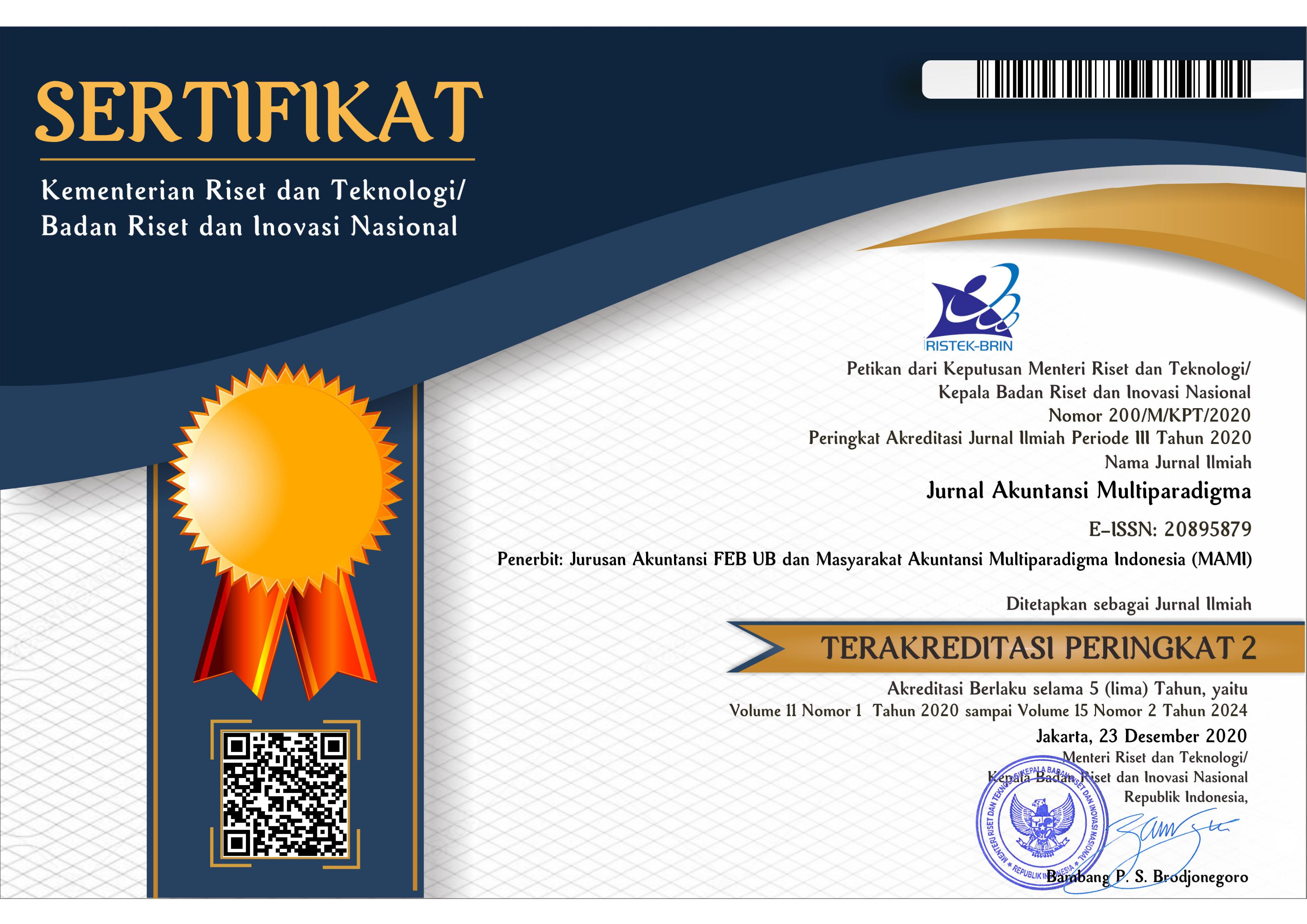BERBAHAYAKAH INSTRUMEN DERIVATIF DALAM KONTEKS AKUNTANSI?
Abstract
Abstrak: Berbahayakah Instrumen Derivatif dalam Konteks Akuntansi? Penelitian ini berusaha untuk memperoleh gambaran yang objektif terkait penggunaan instrumen derivatif sebagai alat lindung nilai. Metode deskriptif kualitatif dgunakan melalui analisis beragam peraturan. Penelitian ini menunjukkan bahwa peraturan lembaga pengawas memungkinkan instrumen derivatif digunakan sebagai alat lindung nilai dan spekulasi. Selain itu, peraturan akuntansi telah mengakui prinsip saling mengkompensasi sehingga instrumen derivatif dapat dimanfaatkan sebagai alat manajemen risiko untuk menurunkan dampak fluktuasi harga. Guna memperkecil dampak negatif dari penggunaan instrumen derivatif, lembaga pengawas telah memberikan batasan harga.
Abstract: Are Derivative Instruments Risky in the Context of Accounting? This study seeks to obtain an objective picture regarding the use of derivative instruments as hedging instruments. Qualitative descriptive methods are used through analysis of various regulations. This study shows that regulatory regulatory body allows derivative instruments to be used as hedging and speculation tools. In addition, accounting regulations have recognized the principle of mutual compensation so that derivative instruments can be used as risk management tools to reduce the impact of price fluctuations. In order to minimize the negative impact of the use of derivative instruments, regulatory agency has set the price limits.
Keywords
Full Text:
PDFReferences
Abdel-Khalik, A. R., & Chen, P. C. (2015). Growth in Financial Derivatives: The Public Policy and Accounting Incentives. Journal of Accounting and Public Policy, 34(3), 291-318. https://doi.org/10.1016/j.jaccpubpol.2015.01.002
Ameer, R. (2009). Value‐Relevance of Foreign‐Exchange and Interest‐Rate Derivatives Disclosure: The Case of Malaysian Firms. The Journal of Risk Finance, 10(1), 78-90. https://doi.org/10.1108/15265940910924517
Anantharaman, D., & Chuk, E. C. (2018). The Economic Consequences of Accounting Standards: Evidence from Risk-Taking in Pension Plans. The Accounting Review, 93(4), 23-51. https://doi.org/10.2308/accr-51937
Angel, J. J., & Mccabe, D. M. (2009). The Ethics of Speculation. Journal of Business Ethics, 90(Supplement 3), 277–286. https://doi.org/10.1007/s10551-010-0421-5
Aragon, G. O., & Martin, J. S. (2012). A Unique View of Hedge Fund Derivatives Usage: Safeguard or Speculation? Journal of Financial Economics, 105(2), 436-456. https://doi.org/10.1016/j.jfineco.2012.02.004
Ayturk, Y., Gurbuz, A. O., & Yanik, S. (2016). Corporate Derivatives Use and Firm Value: Evidence from Turkey. Borsa Istanbul Review, 16(2), 108-120. https://doi.org/10.1016/j.bir.2016.02.001
Bae, S. C., Kwon, T. H., & Park, J. W. (2009), Derivatives Trading, Volatility Spillover, and Regulation: Evidence from the Korean Securities Markets. The Journal of Future Markets, 29(6), 563-597. https://doi.org/10.1002/fut.20384
Banerjee, S., & Graveline, J. J. (2014). Trading in Derivatives When the Underlying is Scarce. Journal of Financial Economics, 111(3), 589-608. https://doi.org/10.1016/j.jfineco.2013.11.008
Bartram, S. M., Brown, G. W., & Conrad, J. (2011). The Effects of Derivatives on Firm Risk and Value. Journal of Financial and Quantitative Analysis, 46(4), 967–999. https://doi.org/10.1017/S0022109011000275
Bean, A., & Irvine, H. (2015). Derivatives Disclosure in Corporate Annual Reports: Bank Analysts' Perceptions of Usefulness. Accounting and Business Research, 45(5), 602-619. https://doi.org/ 10.1080/00014788.2015.1059312
Beneda, N. (2012). The Impact of Hedging with Derivative Instruments on Reported Earnings Volatility. Applied Financial Economics, 23(2), 165-179. https://doi.org/10.1080/09603107.2012.709599
Bezzina, F. H., & Grima, S. (2012). Exploring Factors Affecting the Proper Use of Derivatives: An Empirical Study with Active Users and Controllers of Derivatives. Managerial Finance, 38(4), 414–435. https://doi.org/10.1108/03074351211207554
Birt, J. , Rankin, M., & Song, C. L. (2013), Derivatives Use and Financial Instrument Disclosure in the Extractives Industry. Accounting & Finance, 53(1), 55-83. https://doi.org/10.1111/acfi.12001
Blanco, I., & Wehrheim, D. (2017). The Bright Side of Financial Derivatives: Options Trading and Firm Innovation. Journal of Financial Economics, 125(1), 99-109. https://doi.org/10.1016/j.jfineco.2017.04.004
Brav, A., Wei, J., Song, M., & Xuan, T. (2018). How does Hedge Fund Activism Reshape Corporate Innovation? Journal of Financial Economics, 130(2), 237-264. https://doi.org/10.1016/j.jfineco.2018.06.012
Campello, M., Lin, C., Ma, , & Zou, H. (2011). The Real and Financial Implications of Corporate Hedging. The Journal of Finance, 66(5), 1615–1647. https://doi.org/10.1111/j.1540-6261.2011.01683.x
Charumathi, B., & Kota, H. B. (2012). On the Determinants of Derivative Usage by Large Indian Non-Financial Firms. Global Business Review, 13(2), 251–267. https://doi.org/10.1177/097215091201300205
Donati, M., Zuppiroli, M., Riani, M., & Verga, G. (2016). The Impact of Investors in Agricultural Commodity Derivative Markets. Outlook on Agriculture, 45(1), 25–31. https://doi.org/10.5367/oa.2016.0233
Donohoe, M. P. (2015). Financial Derivatives in Corporate Tax Avoidance: A Conceptual Perspective. The Journal of the American Taxation Association, 37(1), 37-68. https://doi.org/10.2308/atax-50907
Dye, R. A., & Sridhar, S. S. (2016) Hedging Executive Compensation Risk through Investment Banks. The Accounting Review, 91(4), 1109-1138. https://doi.org/10.2308/accr-51291
Ebell, M. (2016). Assessing the Impact of Trade Agreements on Trade. National Institute Economic Review, 238(1), 31–42. https://doi.org/10.1177/002795011623800113
Ellersgaard, S., Jönsson, M., & Poulsen, R. (2017). The Fundamental Theorem of Derivative Trading - Exposition, Extensions and Experiments. Quantitative Finance, 17(4), 515-529. https://doi.org/10.1080/14697688.2016.1222078
Emm, E. E., & Ince, U. (2011). Systemic Risk and Competition in OTC Derivatives Dealing: Evidence from Client Failures. Managerial Finance, 37(12), 1161-1189. https://doi.org/10.1108/03074351111175083
Fischer, M., Hanauer, M. X., & Heigermoser, R. (2016). Synthetic Hedge Funds. Review of Financial Economics, 29, 12-22. https://doi.org/10.1016/j.rfe.2016.02.002
Fong, L., & Han, C. (2015). Impacts of Derivative Markets on Spot Market Volatility and Their Persistence. Applied Economics, 47(22), 2250-2258. https://doi.org/10.1080/00036846.2015.1005813
Ghoddusi, H., & Emamzadehfard, S. (2017). Optimal Hedging in the US Natural Gas Market: The Effect of Maturity and Cointegration. Energy Economics, 63, 92-105. https://doi.org/10.1016/j.eneco.2017.01.018
Giraldo-Prieto, C. A., Uribe, G. J. G., Bermejo, C. V., & Herrera, D. C. F. (2017). Financial Hedging with Derivatives and Its Impact on the Colombian Market Value for Listed Companies. Contaduría y Administración, 62(5), 1572-1590. https://doi.org/10.1016/j.cya.2017.04.009
Golez, B. Expected Returns and Dividend Growth Rates Implied by Derivative Markets. The Review of Financial Studies, 27(3), 790–822. https://doi.org/10.1093/rfs/hht131
Jiang, C., Kawaller, I. G., & Koch, P. D. (2016). Designing a Proper Hedge: Theory versus Practice. Journal of Financial Research, 39(2), 123–144. https://doi.org/10.1111/jfir.12091
Kawaller, I. G., & Koch, P. D. (2013). Hedge Effectiveness Testing Revisited. The Journal of Derivatives, 21(1), 83–94. https://doi.org/10.3905/jod.2013.21.1.083
Kvamvold, J. & Lindset, S. (2017). Index Trading and Portfolio Risk. Journal of Economics and Finance, 41(1), 78-99. https://doi.org/10.1007/s12197-015-9334-6
Lau, C. K. (2016). How Corporate Derivatives Use Impact Firm Performance? Pacific Basin Finance Journal, 40, 102–114. https://doi.org/10.1016/j.pacfin.2016.10.001
Lee, H. J. (2016). Individuals’ Feedback Trading in Market and Limit Trades: Trading Behaviours on the Korean Stock Market. Investment Analysts Journal, 45(3), 212-232. https://doi.org/10.1080/10293523.2016.1173315
Li, J. (2017). Accounting for Banks, Capital Regulation and Risk-Taking. Journal of Banking & Finance, 74, 102-121. https://doi.org/10.1016/j.jbankfin.2016.09.003
Lien, D., & Yu, C. F. J. (2017). Production and Hedging with Optimism and Pessimism under Ambiguity. International Review of Economics & Finance, 50, 122-135. https://doi.org/10.1016/j.iref.2017.04.001
Lien, D., & Zhang, M. (2008). A Survey of Emerging Derivatives Markets. Emerging Markets Finance and Trade, 44(2), 39–69. https://doi.org/10.2753/REE1540-496X440203
Lins, K. V., Servaes, H., & Tamayo, A. (2011). Does Fair Value Reporting Affect Risk Management? International Survey Evidence. Financial Management, 40(3), 525–551. https://doi.org/10.1111/j.1755-053X.2011.01152.x
Listokin‐Smith, S. (2013). Meta‐Regulation of OTC Derivatives Contracts Post Reform. Journal of Financial Regulation and Compliance, 21(2), 188-200. https://doi.org/10.1108/13581981311315677
Meyer, D. R., & Guernsey, G. (2017). Hong Kong and Singapore Exchanges Confront High Frequency Trading. Asia Pacific Business Review, 23(1), 63-89. https://doi.org/10.1080/13602381.2016.1157927
Muellerleile, C. (2015). Speculative boundaries: Chicago and the Regulatory History of US Financial Derivative Markets. Environment and Planning A: Economy and Space, 47(9), 1805–1823. https://doi.org/10.1068/a130343p
Narasimhan, M. S., & Kalra, S. (2014). The Impact of Derivative Trading on the Liquidity of Stocks. Vikalpa, 39(3), 51–66. https://doi.org/10.1177/0256090920140304
Nunez, K. (2012). The Federal Energy Regulatory Commission and Derivatives. Journal of Financial Reporting and Accounting, 10(1), 55-72. https://doi.org/10.1108/19852511211237444
Olgun, O., & Yetkiner, I. H. (2011). Determination of Optimal Hedging Strategy for Index Futures: Evidence from Turkey. Emerging Markets Finance and Trade, 47(6), 68-79. https://doi.org/10.2753/REE1540-496X470604
Olson, E., Vivian, A., & Wohar, M. E. (2017). Do Commodities Make Effective Hedges for Equity Investors? Research in International Business and Finance, 42, 1274-1288. https://doi.org/10.1016/j.ribaf.2017.07.064
Pal, S. N., & Chattopadhyay, A. K. (2014). Impact of Introducing Different Financial Derivative Instruments in India on Its Stock Market Volatility. Paradigm, 18(2), 135–153. https://doi.org/10.1177/0971890714558704
Pirrong, C. (2010), Derivatives Clearing Mandates: Cure or Curse? Journal of Applied Corporate Finance, 22(3), 48-55. https://doi.org/10.1111/j.1745-6622.2010.00289.x
Rakowski, D., Shirley, S. E., & Stark, J. R. (2017). Tail-Risk Hedging, Dividend Chasing, and Investment Constraints: The Use of Exchange-Traded Notes by Mutual Funds. Journal of Empirical Finance, 44, 91-107. https://doi.org/10.1016/j.jempfin.2017.08.003
Ramirez, J. (2013). Accounting for Derivatives: Advanced Hedging under IFRS. West Sussex: John Wiley & Sons Ltd.
Riederová, S., & Růžičková, K. (2011). Historical Development of Derivatives’ Underlying Assets. Acta Universitatis Agriculturae et Silviculturae Mendelianae Brunensis, 59(7), 521–526. https://doi.org/10.11118/actaun201159070521
Ryu, D. (2015), The Information Content of Trades: An Analysis of KOSPI 200 Index Derivatives. Journal of Futures Markets, 35(3), 201-221. https://doi.org/10.1002/fut.21637
Sanfelici, S., Curato, I. V., & Mancino, M. EV. (2015). High-Frequency Volatility of Volatility Estimation Free from Spot Volatility Estimates, Quantitative Finance, 15(8), 1331-1345, https://doi.org/ 10.1080/14697688.2015.1032542
Scherp, H. A. (2013). Quantifying Qualitative Data Using Cognitive Maps. International Journal of Research & Method in Education, 36(1), 67-81. https://doi.org/10.1080/1743727X.2012.696244
Sekaran, U., & Bougie, R. (2016). Research Method for Business: A Skill-Buidling Approach (7th ed.). West Sussex: John Wiley & Sons Ltd.
Shen, X., & Hartarska, V. (2013). Derivatives as Risk Management and Performance of Agricultural Banks. Agricultural Finance Review, 73(2), 290-309. https://doi.org/10.1108/AFR-07-2012-0036
Shum, W. C., Kan, A. C. N., & Chen, T. (2014). Does Warrant Trading Matter in Tracking Errors of China-Focused Exchange-Traded Funds? The Chinese Economy, 47(1), 53-66. https://doi.org/10.2753/CES1097-1475470103
Smith, P. A., & Kohlbeck, M. A. (2008). Accounting for Derivatives and Hedging Activities: Comparison of Cash Flow versus Fair Value Hedge Accounting. Issues in Accounting Education, 23(1), 103-117. https://doi.org/10.2308/iace.2008.23.1.103
Sousa, D. (2014). Validation in Qualitative Research: General Aspects and Specificities of the Descriptive Phenomenological Method. Qualitative Research in Psychology, 11(2), 211-227. https://doi.org/10.1080/14780887.2013.853855
Stoll, H. R. (2014), High Speed Equities Trading: 1993–2012. Asia-Pacific Journal of Financial Studies, 43(6), 767-797. https://doi.org/10.1111/ajfs.12078
Stulz, R. M. (2013). How Companies Can Use Hedging to Create Shareholder Value. Journal of Applied Corporate Finance, 25(4), 74–86. https://doi.org/10.1111/jacf.12281
Sun, H., Donohoe, M., & Sougiannis, T. (2016). Do Analysts Understand the Economic and Reporting Complexities of Derivatives ? Journal of Accounting and Economics, 61(2–3), 584–604. https://doi.org/10.1016/j.jacceco.2015.07.005
Trang, K. H. (2018). Financial Derivatives Use and Multifaceted Exposures: Evidence from East Asian Non-Financial Firms. Journal of Asian Business and Economic Studies, 25(1), 86-108. https://doi.org/10.1108/JABES-04-2018-0004
Zhang, H. (2009). Effect of Derivative Accounting Rules on Corporate Risk-Management Behavior. Journal of Accounting and Economics, 47(3), 244–264. https://doi.org/10.1016/j.jacceco.2008.11.007
Zhou, R., Li, J. S. H., & Pai, J. (2016). Hedging Crop Yield with Exchange-Traded Weather Derivatives. Agricultural Finance Review, 76(1), 172-186. https://doi.org/10.1108/AFR-11-2015-0045
DOI: http://dx.doi.org/10.18202/jamal.2018.04.9025
Refbacks
- There are currently no refbacks.
Copyright (c) 2018 Dewa Mahardika

This work is licensed under a Creative Commons Attribution-NonCommercial 4.0 International License.

















